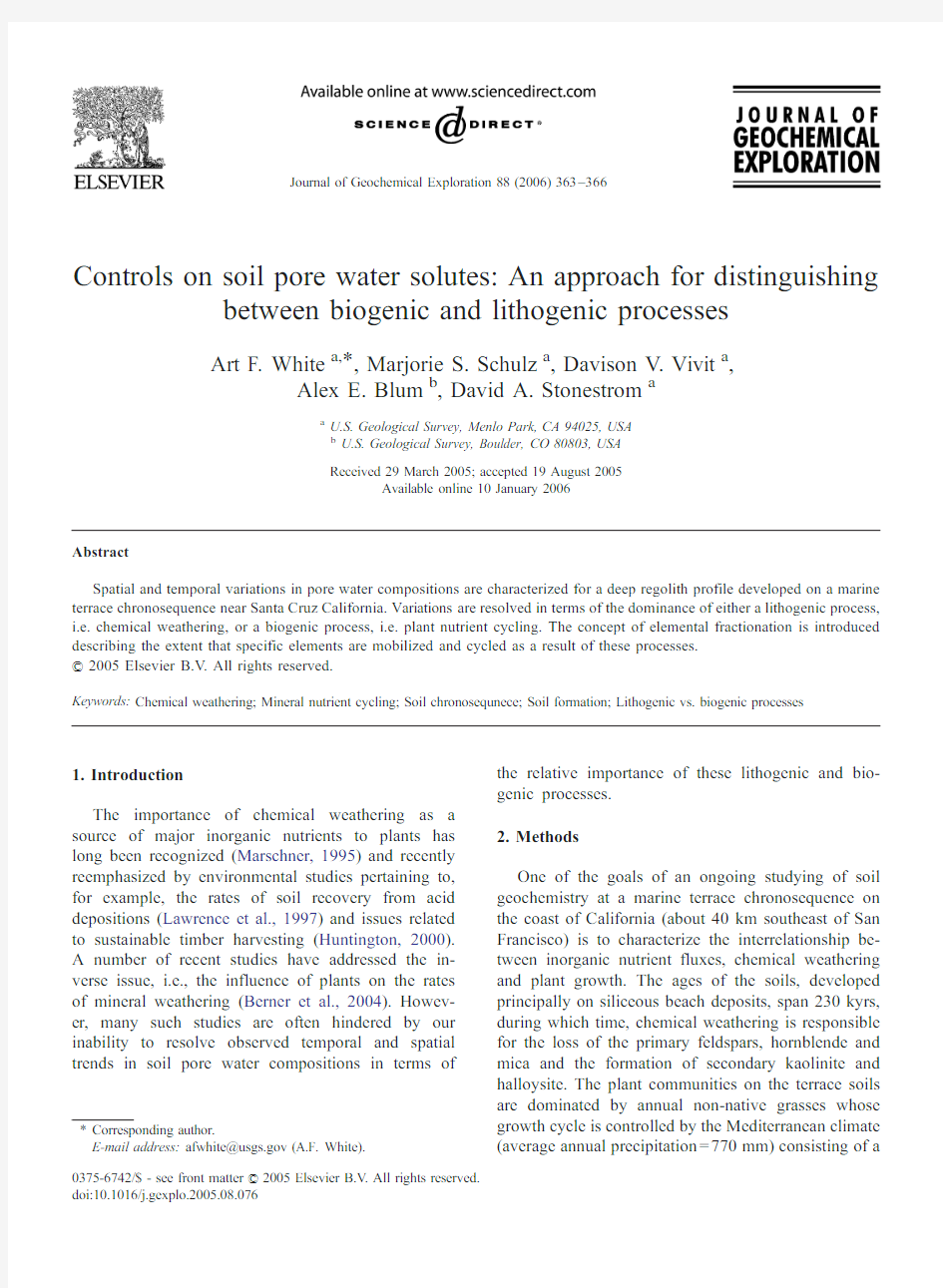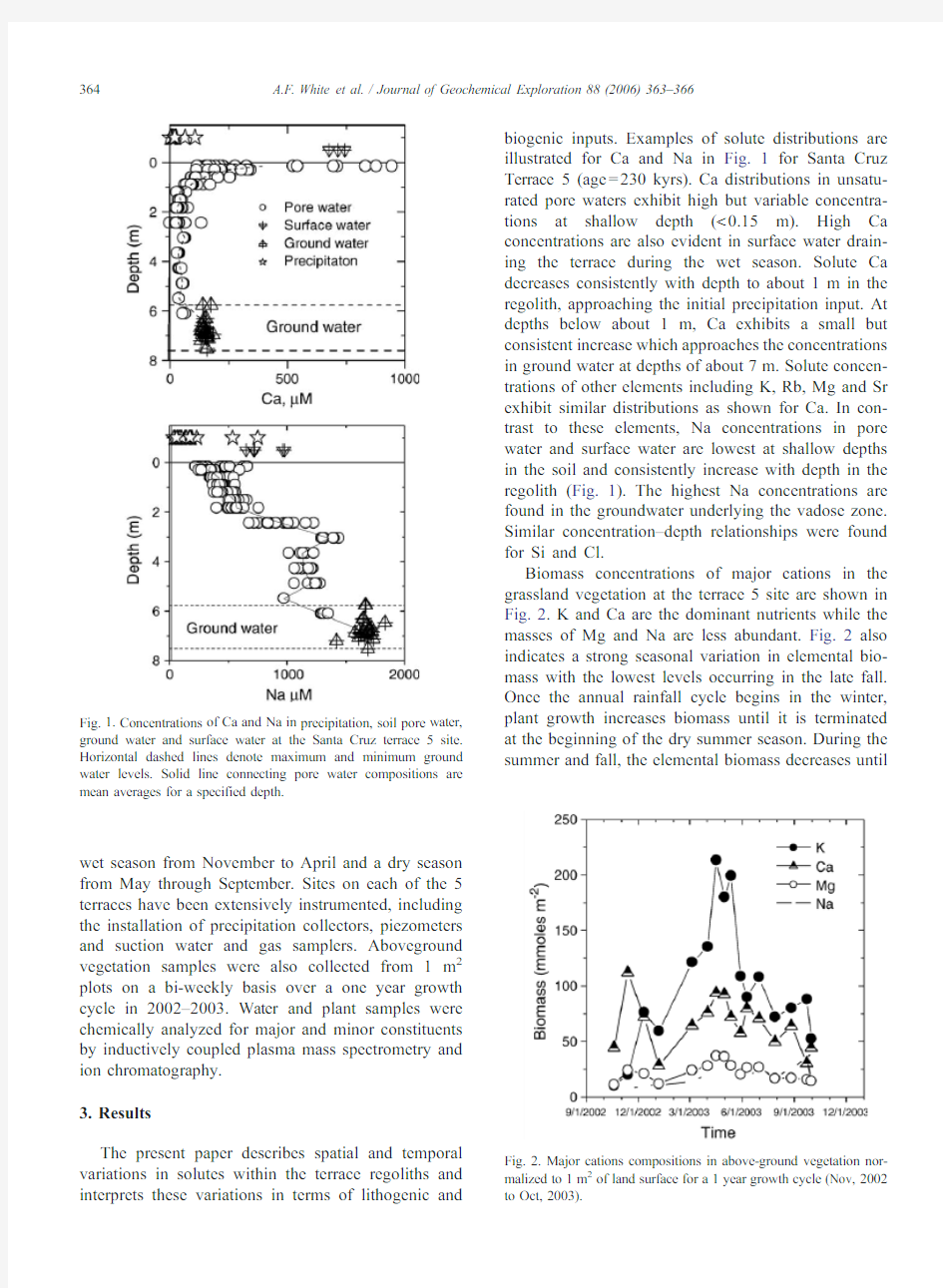An approach for distinguishing between biogenic and lithogenic processes


Controls on soil pore water solutes:An approach for distinguishing
between biogenic and lithogenic processes
Art F.White a,*,Marjorie S.Schulz a ,Davison V .Vivit a ,
Alex E.Blum b ,David A.Stonestrom a
a
U.S.Geological Survey,Menlo Park,CA 94025,USA b
U.S.Geological Survey,Boulder,CO 80803,USA Received 29March 2005;accepted 19August 2005
Available online 10January 2006
Abstract
Spatial and temporal variations in pore water compositions are characterized for a deep regolith profile developed on a marine terrace chronosequence near Santa Cruz California.Variations are resolved in terms of the dominance of either a lithogenic process,i.e.chemical weathering,or a biogenic process,i.e.plant nutrient cycling.The concept of elemental fractionation is introduced describing the extent that specific elements are mobilized and cycled as a result of these processes.D 2005Elsevier B.V .All rights reserved.
Keywords:Chemical weathering;Mineral nutrient cycling;Soil chronosequnece;Soil formation;Lithogenic vs.biogenic processes
1.Introduction
The importance of chemical weathering as a source of major inorganic nutrients to plants has long been recognized (Marschner,1995)and recently reemphasized by environmental studies pertaining to,for example,the rates of soil recovery from acid depositions (Lawrence et al.,1997)and issues related to sustainable timber harvesting (Huntington,2000).A number of recent studies have addressed the in-verse issue,i.e.,the influence of plants on the rates of mineral weathering (Berner et al.,2004).Howev-er,many such studies are often hindered by our inability to resolve observed temporal and spatial trends in soil pore water compositions in terms of
the relative importance of these lithogenic and bio-genic processes.2.Methods
One of the goals of an ongoing studying of soil geochemistry at a marine terrace chronosequence on the coast of California (about 40km southeast of San Francisco)is to characterize the interrelationship be-tween inorganic nutrient fluxes,chemical weathering and plant growth.The ages of the soils,developed principally on siliceous beach deposits,span 230kyrs,during which time,chemical weathering is responsible for the loss of the primary feldspars,hornblende and mica and the formation of secondary kaolinite and halloysite.The plant communities on the terrace soils are dominated by annual non-native grasses whose growth cycle is controlled by the Mediterranean climate (average annual precipitation =770mm)consisting of a
0375-6742/$-see front matter D 2005Elsevier B.V .All rights reserved.doi:10.1016/j.gexplo.2005.08.076
*Corresponding author.
E-mail address:afwhite@https://www.360docs.net/doc/ec13910971.html, (A.F.White).
Journal of Geochemical Exploration 88(2006)363
–366
wet season from November to April and a dry season from May through September.Sites on each of the 5terraces have been extensively instrumented,including the installation of precipitation collectors,piezometers and suction water and gas samplers.Aboveground vegetation samples were also collected from 1m 2plots on a bi-weekly basis over a one year growth cycle in 2002–2003.Water and plant samples were chemically analyzed for major and minor constituents by inductively coupled plasma mass spectrometry and ion chromatography.3.Results
The present paper describes spatial and temporal variations in solutes within the terrace regoliths and interprets these variations in terms of lithogenic and
biogenic inputs.Examples of solute distributions are illustrated for Ca and Na in Fig.1for Santa Cruz Terrace 5(age =230kyrs).Ca distributions in unsatu-rated pore waters exhibit high but variable concentra-tions at shallow depth (b 0.15m).High Ca concentrations are also evident in surface water drain-ing the terrace during the wet season.Solute Ca decreases consistently with depth to about 1m in the regolith,approaching the initial precipitation input.At depths below about 1m,Ca exhibits a small but consistent increase which approaches the concentrations in ground water at depths of about 7m.Solute concen-trations of other elements including K,Rb,Mg and Sr exhibit similar distributions as shown for Ca.In con-trast to these elements,Na concentrations in pore water and surface water are lowest at shallow depths in the soil and consistently increase with depth in the regolith (Fig.1).The highest Na concentrations are found in the groundwater underlying the vadose zone.Similar concentration–depth relationships were found for Si and Cl.
Biomass concentrations of major cations in the grassland vegetation at the terrace 5site are shown in Fig.2.K and Ca are the dominant nutrients while the masses of Mg and Na are less abundant.Fig.2also indicates a strong seasonal variation in elemental bio-mass with the lowest levels occurring in the late fall.Once the annual rainfall cycle begins in the winter,plant growth increases biomass until it is terminated at the beginning of the dry summer season.During the summer and fall,the elemental biomass decreases
until
Fig.1.Concentrations of Ca and Na in precipitation,soil pore water,ground water and surface water at the Santa Cruz terrace 5site.Horizontal dashed lines denote maximum and minimum ground water levels.Solid line connecting pore water compositions are mean averages for a specified
depth.
Fig.2.Major cations compositions in above-ground vegetation nor-malized to 1m 2of land surface for a 1year growth cycle (Nov,2002to Oct,2003).
A.F .White et al./Journal of Geochemical Exploration 88(2006)363–366
364
a minimum value is reached which is comparable to the starting composition measured in the preceding fall.4.Discussion
The differences in individual elements distributions is further resolved by comparing elemental concentra-
tions as shown in Fig.3for Na,Mg and K plotted against Ca.When the pore water data are plotted in this fashion,dual trends in elemental compositions emerge.These trends are most differentiated in the case of Na/Ca with one subset of the solute data exhibiting very high Na/Ca ratios and the other set exhibiting much lower ratios.The dual trends become less separated in the case of Mg/Ca and,in the case of the K/Ca,all of the pore waters fall essentially along a single trend.The elemental trends are spatially resolved in Fig.3by differentiating pore waters sampled above 1m depth (open circles)and pore waters sampled below 1m (closed circles).In addition,the groundwater composi-tions plot along or near the deep pore water trends and the surface water samples plot along the shallow pore water trends (except for K/Ca).
Our hypothesis is that the dual elemental trends shown in Fig.3for pore water,as well as surface and ground water resolve the biogenic and lithogenic pro-cesses that occur in the regolith.Several lines of evi-dence support this idea.The spatial separation of the elemental trends at about 1m depth corresponds to the presence of an argillic kaolinite/halloysite horizon which becomes more prominent with increases in ter-race age and is most strongly developed in the oldest Terrace 5regolith.Hydrologic data indicate that it forms a significant aquitard,limiting pore water re-charge to the deeper regolith.The horizon also coin-cides with the maximum rooting depth of much of the grassland vegetation.
An additional observation is that the concentrations of elements along the lithogenic trends in Fig.3are spatially dependent.For example,higher Na concentra-tions occur at progressively greater depths in the rego-lith (Fig.1).Increasing depth corresponds to greater fluid residence times and more plagioclase weathering,the principle source of lithogenic Na.In contrast,the biogenic trend is temporally dependent,i.e.,the highest pore water Ca concentrations at shallow depth occur during initial recharge in the late fall which corresponds to the maximum leaching and remobilization of the dormant biomass (Fig.2).
Finally,and perhaps the interesting observation,is that the relative separation between the shallow and deep elemental trends shown in Fig.3correspond to relative mobility of different elements during the litho-genic and biogenic processes.The separation between the dual Na/Ca trends is greatest due to the fact that Na is the dominant cation released during the weathering process,whereas Na is not a significant nutrient and is generally excluded from uptake by vegetation (Fig.2).In contrast,the separation between the lithogenic
and
https://www.360docs.net/doc/ec13910971.html,parison of Na,Mg and K to Ca concentrations in pore water,surface water,ground water and precipitation.Open circles denote pore waters sampled above 1m in the regolith and closed circles pore waters sampled below 1m depth.Diagonal lines denote approximate trends controlled by lithogenic and biogenic processes.
A.F .White et al./Journal of Geochemical Exploration 88(2006)363–366365
biogenic Mg/Ca trends are less because less Mg is released by weathering and Mg is a taken up to a greater degree by plants than Na.Finally,the K/Ca trends are unresolved because of the very limited mo-bility of K during weathering,coupled with strong cycling of both Ca and K in the plant biomass(Fig.
2).The extent of the divergence in the trends for any2 elements describes their relative fractionation by litho-genic and biogenic processes.The position along any trend corresponds to the relative intensity of the specific process,i.e.weathering or biologic cycling.
5.Conclusions
Major chemical species in pore water,surface water and ground water associated with soils in the Santa Cruz chronosequence exhibit significant variations which can be resolved in terms of the dominance of either a lithogenic process,i.e.,chemical weathering,or a biogenic process,i.e.,plant nutrient cycling.The ability to uniquely resolve these solute variations is attributed in part to specific characteristics of the Santa Cruz site,e.g.,the development of a prominent argillic horizon which spatially isolates the lithogenic and biogenic processes,and to the strong season control on hydrology and plant growth.Although both process-es occur in most soil environments,resolution compa-rable to that obtained in this study may be more difficult.The ongoing development and use of other parameters,including Sr,Ca and Si isotopes and Ge/Si ratios will further our ability to distinguish between biogenic and lithogenic processes in such soils. References
Berner,E.K.,Berner,R.A.,Moilton,K.L.,2004.Plants and mineral weathering:past and present.In:Drever,J.I.(Eds.),Surface and Groundwater,Weathering,Erosion and Soils,vol.5.Elsevier. Huntington,T.G.,2000.The potential for calcium depletion in forest ecosystems of the southeastern United States:review and analysis.
Glob.Biogeochem.Cycles14,623–638.
Lawrence,G.B.,David,M.B.,Bailey,S.W.,Shortle,W.C.,1997.
Assessment of soil calcium status in red spruce forests in the northeastern United States.Biogeochemistry,19–39. Marschner,H.,1995.Mineral Nutrition of Higher Plants.Academic Press.
A.F.White et al./Journal of Geochemical Exploration88(2006)363–366 366
